Vessel Tracking Using Bistatic Compact HFSWR
Abstract
:1. Introduction
2. Target Detection and Tracking with a Bistatic Compact HFSWR
2.1. Target Representation with a Bistatic Compact HFSWR
2.2. Target Tracking with a Bistatic Compact HFSWR
3. Experiment Results
- Track initiation—M is chosen to be equal to 3, and N is 4.
- Data association—The validation gate thresholds of range, azimuth, and Doppler velocity for monostatic HFSWR are 1.5 km, 5, and 1 km/h, while those for bistatic HFSWR are set to 4 km, 5, and 1.5 km/h, respectively. The weights , , and for monostatic radar are 0.6, 0.3, and 0.1, while those for bistatic radar are set to 0.7, 0.2, and 0.1, respectively.
- Track termination—K is set to be 3 and L is 5. The maximum target velocity is set to 70 km/h.
4. Discussion
5. Conclusions
Author Contributions
Funding
Acknowledgments
Conflicts of Interest
Abbreviations
| HFSWR | High-Frequency Surface Wave Radar |
| MUSIC | Multiple SIgnal Classfication |
| MIMO | Multiple-Input Multiple-Output |
| MTT | Multi-Target Tracking |
| DBF | Digital Beam Forming |
| CMKF | Converted Measurement Kalman Filter |
| AIS | Automatic Identification System |
| RMSE | Root Mean Square Error |
References
- Sevgi, L.; Ponsford, A.; Chan, H.C. An integrated maritime surveillance system based on high-frequency surface-wave radars. 1. Theoretical background and numerical simulations. IEEE Antenn. Propag. Mag. 2001, 43, 28–43. [Google Scholar] [CrossRef]
- Green, D.; Gill, E.; Huang, W. An inversion method for extraction of wind speed from high-frequency ground-wave radar. IEEE Trans. Geosci. Remote Sens. 2009, 47, 3530–3549. [Google Scholar] [CrossRef]
- Ponsford, A.M.; Wang, J. A review of high frequency surface wave radar for detection and tracking of ships. Turk. J. Elect. Eng. Comput. Sci. 2010, 18, 409–428. [Google Scholar]
- Park, S.; Cho, C.J.; Ku, B.; Lee, S.; Ko, H. Compact HF surface wave radar data generating simulator for ship detection and tracking. IEEE Geosci. Remote Sens. Lett. 2017, 14, 969–973. [Google Scholar] [CrossRef]
- Roarty, H.J.; Lemus, E.R.; Handel, E.; Glenn, S.M.; Barrick, D.E.; Isaacson, J. Performance evaluation of SeaSonde high-frequency radar for vessel detection. Mar. Technol. Soc. J. 2011, 45, 14–24. [Google Scholar] [CrossRef]
- Smith, M.; Roarty, H.J.; Glenn, S.; Whelan, C.; Barrick, D.E.; Isaacson, J. Methods of associating CODAR SeaSonde vessel detection data into unique tracks. In Proceedings of the MTS/IEEE Oceans, San Diego, CA, USA, 23–27 September 2013; pp. 1–5. [Google Scholar]
- Lu, B.; Wen, B.; Tian, Y.; Wang, R. A vessel detection method using compact-array HF radar. IEEE Geosci. Remote Sens. Lett. 2017, 14, 2017–2021. [Google Scholar] [CrossRef]
- Helzel, T.; Hansen, B.; Kniephphoff, M.; Petersen, L.; Valentin, M. Introduction of the compact HF radar WERA-S. In Proceedings of the IEEE/OES Baltic International Symposium, Klaipeda, Lithuania, 8–10 May 2012; pp. 1–3. [Google Scholar]
- Ji, Y.; Zhang, J.; Wang, Y.; Sun, W.; Li, M. Target monitoring using small-aperture compact high-frequency surface wave radar. IEEE Aerosp. Electron. Syst. Mag. 2018, 33, 22–31. [Google Scholar] [CrossRef]
- Sun, W.; Huang, W.; Ji, Y.; Dai, Y.; Ren, P.; Zhou, P. Vessel tracking with small-aperture compact high-frequency surface wave radar. In Proceedings of the MTS/IEEE Oceans, Marseille, France, 17–20 June 2019; pp. 1–4. [Google Scholar]
- Sun, W.; Huang, W.; Ji, Y.; Dai, Y.; Ren, P.; Zhou, P.; Hao, X. A vessel azimuth and course joint re-estimation method for compact HFSWR. IEEE Trans. Geosci. Remote Sens. 2020, 58, 1041–1051. [Google Scholar] [CrossRef]
- Yao, G.; Xie, J.; Huang, W. First-order ocean surface cross section for shipborne HFSWR incorporating a horizontal oscillation motion model. IET Radar Sonar Navig. 2018, 12, 973–978. [Google Scholar] [CrossRef]
- Chen, Z.; He, C.; Zhao, C.; Xie, F. Enhanced target detection for HFSWR by 2-D MUSIC based on sparse recovery. IEEE Geosci. Remote Sens. Lett. 2017, 14, 1983–1987. [Google Scholar] [CrossRef]
- Barca, P.; Maresca, S.; Grasso, R.; Bryan, K.; Horstmann, J. Maritime surveillance with multiple over-the-horizon HFSW radars: An overview of recent experimentation. IEEE Aerosp. Electron. Syst. Mag. 2015, 30, 4–18. [Google Scholar] [CrossRef]
- Lesturgie, M. Improvement of high-frequency surface waves radar performances by use of multiple-input multiple-output configurations. IET Radar Sonar Navig. 2008, 3, 49–61. [Google Scholar] [CrossRef]
- Anderson, S.J.; Edwards, P.J.; Marrone, P.; Abramovich, Y.I. Investigations with SECAR- a bistatic HF surface wave radar. In Proceedings of the 2003 International Conference on Radar, Adelaide, Australia, 3–5 September 2003; pp. 717–722. [Google Scholar]
- Marrone, P.; Edwards, P. The case for bistatic HF surface wave radar. In Proceedings of the 2008 Proceedings of the International Conference on Radar, Adelaide, Australia, 2–5 September 2008; pp. 633–638. [Google Scholar]
- Anderson, S.J. Optimizing HF Radar Siting for Surveillance and Remote Sensing in the Strait of Malacca. IEEE Geosci. Remote Sens. Lett. 2012, 51, 1805–1816. [Google Scholar] [CrossRef]
- Xie, J.; Sun, M.; Ji, Z. Space-time model of the first-order sea clutter in onshore bistatic high frequency surface wave radar. IET Radar Sonar Navig. 2015, 9, 55–61. [Google Scholar] [CrossRef]
- Wang, J.; Dizaji, R.; Ponsford, A.M. Analysis of clutter distribution in bistatic high frequency surface wave radar. In Proceedings of the Canadian Conference on Electrical and Computer Engineering, Ontario, QC, Canada, 2–5 May 2004; pp. 1301–1304. [Google Scholar]
- Liu, C.; Chen, B.; Zhang, S. Co-channel interference suppression by time and range adaptive processing in bistatic high-frequency surface wave synthesis impulse and aperture radar. IET Radar Sonar Navig. 2009, 3, 638–645. [Google Scholar] [CrossRef]
- Gill, E.; Walsh, J. High frequency bistatic cross section of the ocean surface. Radio Sci. 2001, 36, 1459–1476. [Google Scholar] [CrossRef]
- Gill, E.; Huang, W.; Walsh, J. The effect of the bistatic scattering angle on the high-frequency radar cross sections of the ocean surface. IEEE Geosci. Remote Sens. Lett. 2008, 5, 143–146. [Google Scholar] [CrossRef]
- Ma, Y.; Gill, E.; Huang, W. Bistatic high-frequency radar ocean surface cross section incorporating a dual-frequency platform motion model. IEEE J. Ocean. Eng. 2018, 43, 205–210. [Google Scholar] [CrossRef]
- Ma, Y.; Huang, W.; Gill, E. Bistatic high frequency radar ocean surface cross section for an FMCW source with an antenna on a floating platform. Int. J. Antennas Propag. 2016, 2016, 8675964. [Google Scholar] [CrossRef] [Green Version]
- Ma, Y.; Gill, E.; Huang, W. First-Order Bistatic high-Frequency radar ocean surface cross-section for an antenna on a floating platform. IET Radar Sonar Navig. 2016, 10, 1136–1144. [Google Scholar] [CrossRef] [Green Version]
- Gill, E.; Huang, W.; Walsh, J. On the development of a second-order bistatic radar cross section of the ocean surface—A high-frequency result for a finite scattering patch. IEEE J. Ocean. Eng. 2006, 31, 740–750. [Google Scholar] [CrossRef]
- Ma, Y.; Huang, W.; Gill, E. The second-order bistatic high frequency radar ocean surface cross section for an antenna on a floating platform. Can. J. Remote Sens. 2016, 42, 332–343. [Google Scholar] [CrossRef]
- Lipa, B.; Whelan, C.; Rector, B.; Nyden, B. HF radar bistatic measurement of surface current velocities: Drifter comparisons and radar consistency checks. Remote Sens. 2009, 1, 1190–1211. [Google Scholar] [CrossRef] [Green Version]
- Yang, J.; Wen, B.; Zhang, C.; Huang, X.; Yan, Z.; Shen, W. A bistatic HF radar for surface current mapping. IEICE Electron. Expr. 2010, 7, 1435–1440. [Google Scholar] [CrossRef] [Green Version]
- Trizna, D.B. A bistatic HF radar for current mapping and robust ship tracking. In Proceedings of the MTS/IEEE Oceans, Quebec City, QC, Canada, 15–18 September 2008; pp. 1–6. [Google Scholar]
- Hardman, R.L.; Wyatt, L.R.; Engleback, C.C. Measuring the directional ocean spectrum from simulated bistatic HF radar data. Remote Sens. 2020, 12, 313. [Google Scholar] [CrossRef] [Green Version]
- Huang, W.; Gill, E.; Wu, X.; Li, L. Measurement of sea surface wind direction using bistatic high-frequency radar. IEEE Trans. Geosci. Remote Sens. 2012, 50, 4117–4122. [Google Scholar] [CrossRef]
- Chan, H.C.; Davies, T.W.; Hall, P. Iceberg tracking using HF surface wave radar. In Proceedings of the MTS/IEEE Oceans, Halifax, NS, Canada, 6–9 October 1997; pp. 1290–1296. [Google Scholar]
- Vivone, G.; Braca, P.; Horstmann, P. Knowledge-based multi-target ship tracking for HF surface wave radar systems. IEEE Trans. Geosci. Remote Sens. 2015, 53, 3931–3949. [Google Scholar] [CrossRef] [Green Version]
- Braca, P.; Marano, S.; Matta, V.; Willett, P. Asymptotic efficiency of the PHD in multitarget/multisensor estimation. IEEE J. Sel. Top. Signal Process. 2013, 7, 553–564. [Google Scholar] [CrossRef]
- Zong, H.; Yu, C.; Zhou, G.; Quan, T. Track initiation in monostatic-bistatic composite high frequency surface wave radar network based on NFE model. In Proceedings of the 2010 International Conference on Electronics and Information Engineering, Kyoto, Japan, 1–3 August 2010; pp. 81–85. [Google Scholar]
- Bar-Shalom, Y.; Willett, P.; Tian, X. Tracking and Data Fusion: A Handbook of Algorithms; YBS Publishing: Storrs, CT, USA, 2011. [Google Scholar]
- Nikolic, D.; Stojkovic, N.; Lekic, N. Maritime over the horizon sensor integration: High frequency surface-wave-radar and automatic identification system data integration algorithm. Sensors 2018, 18, 1147. [Google Scholar] [CrossRef] [Green Version]
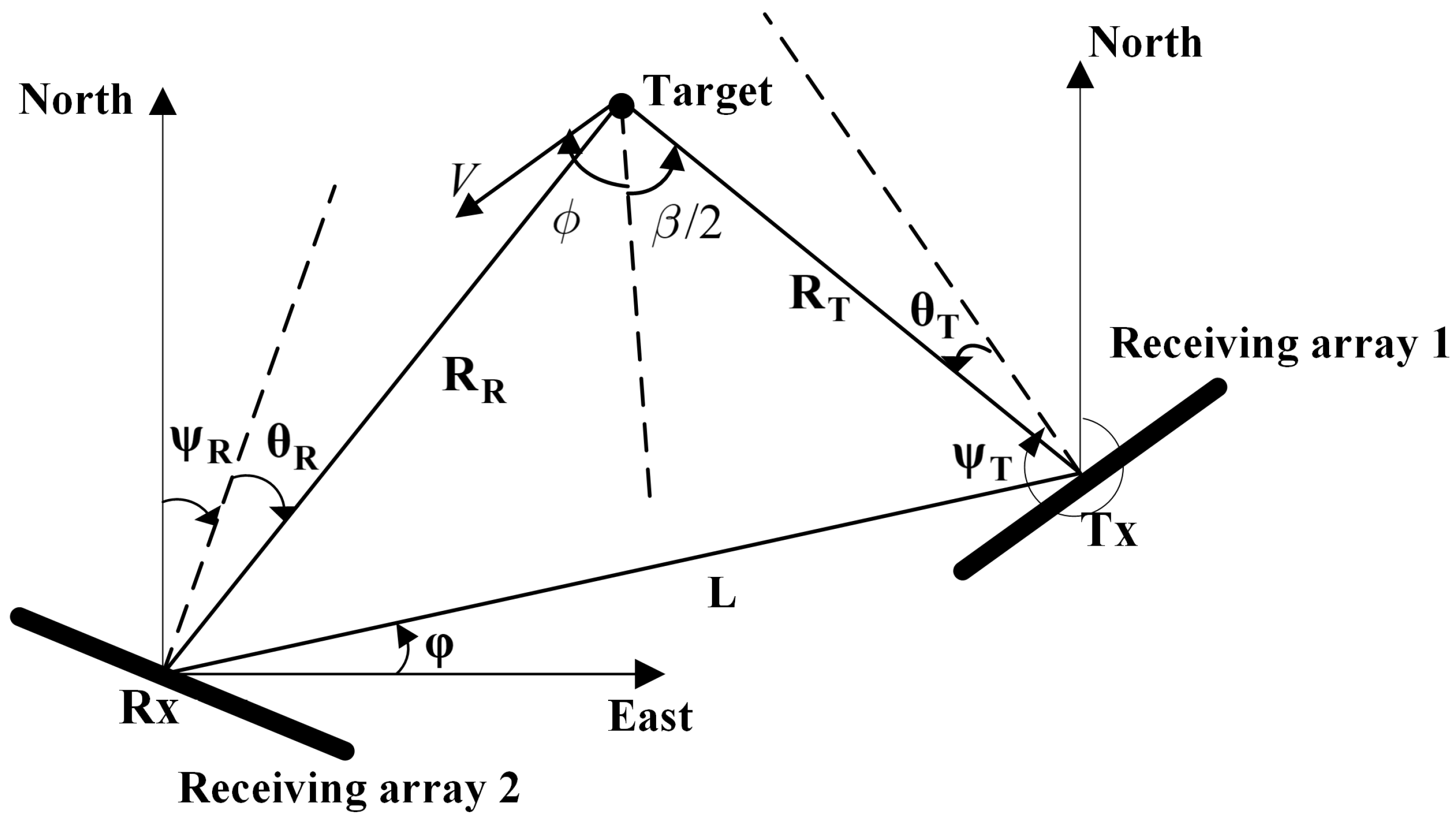
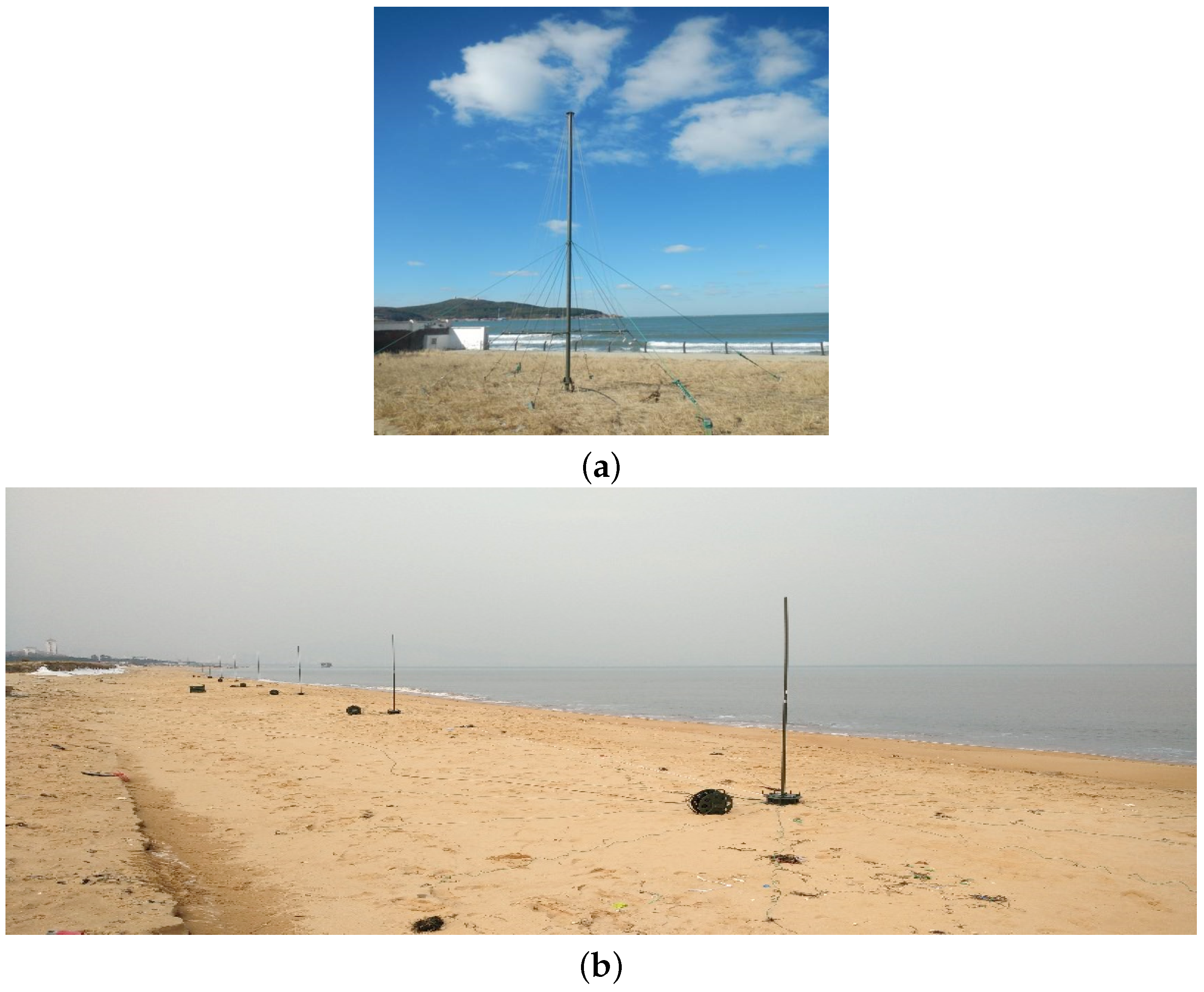
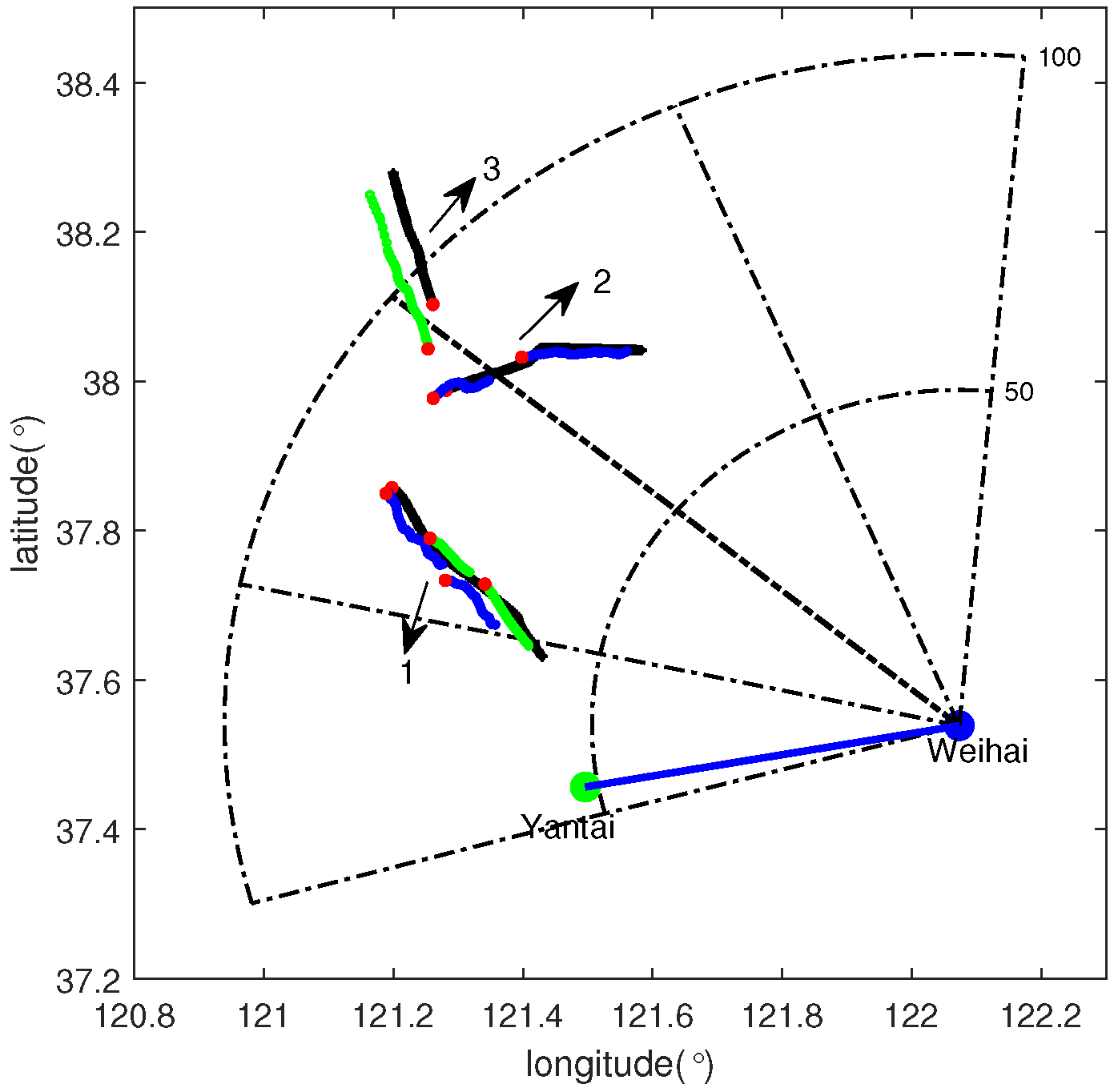
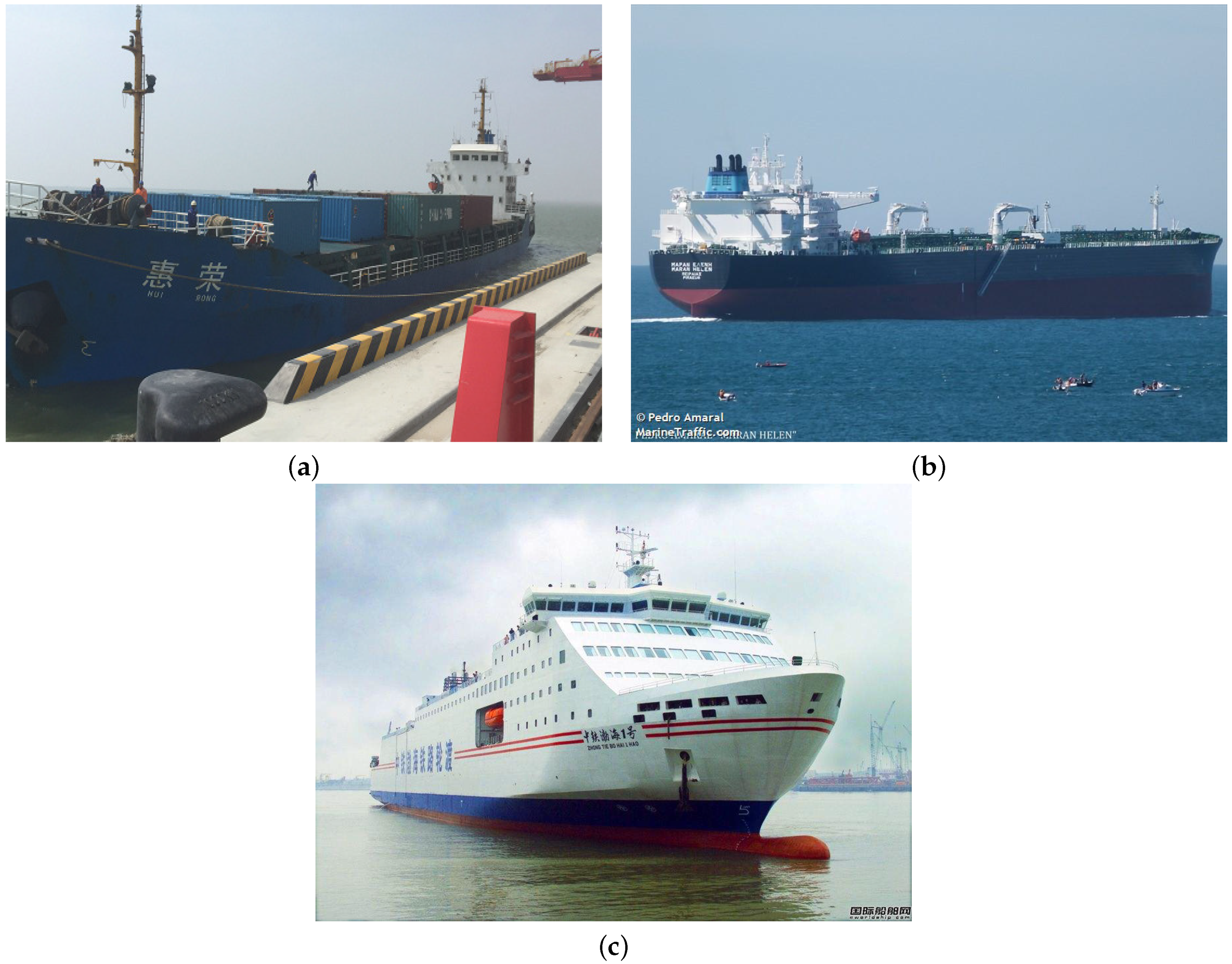

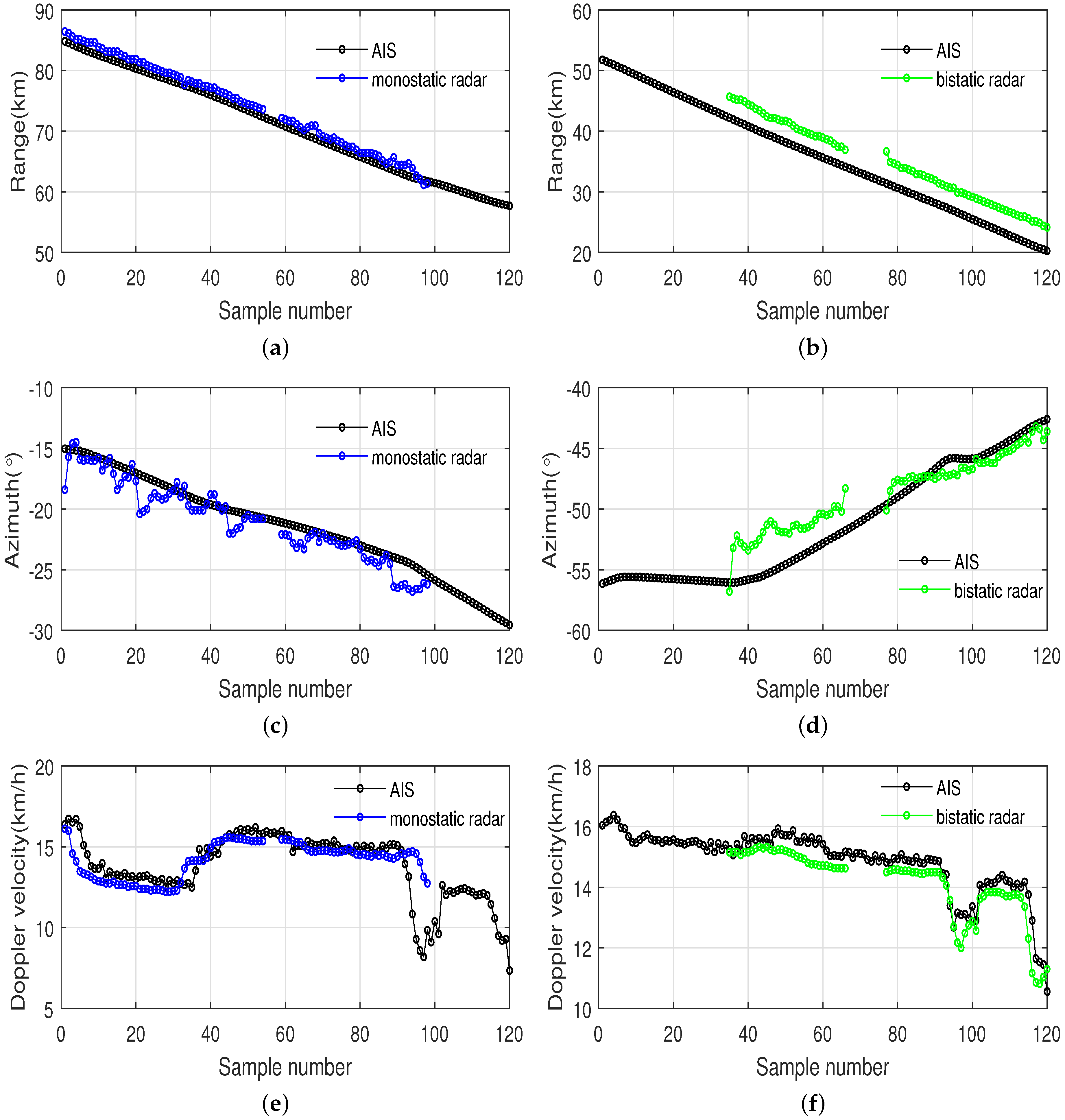
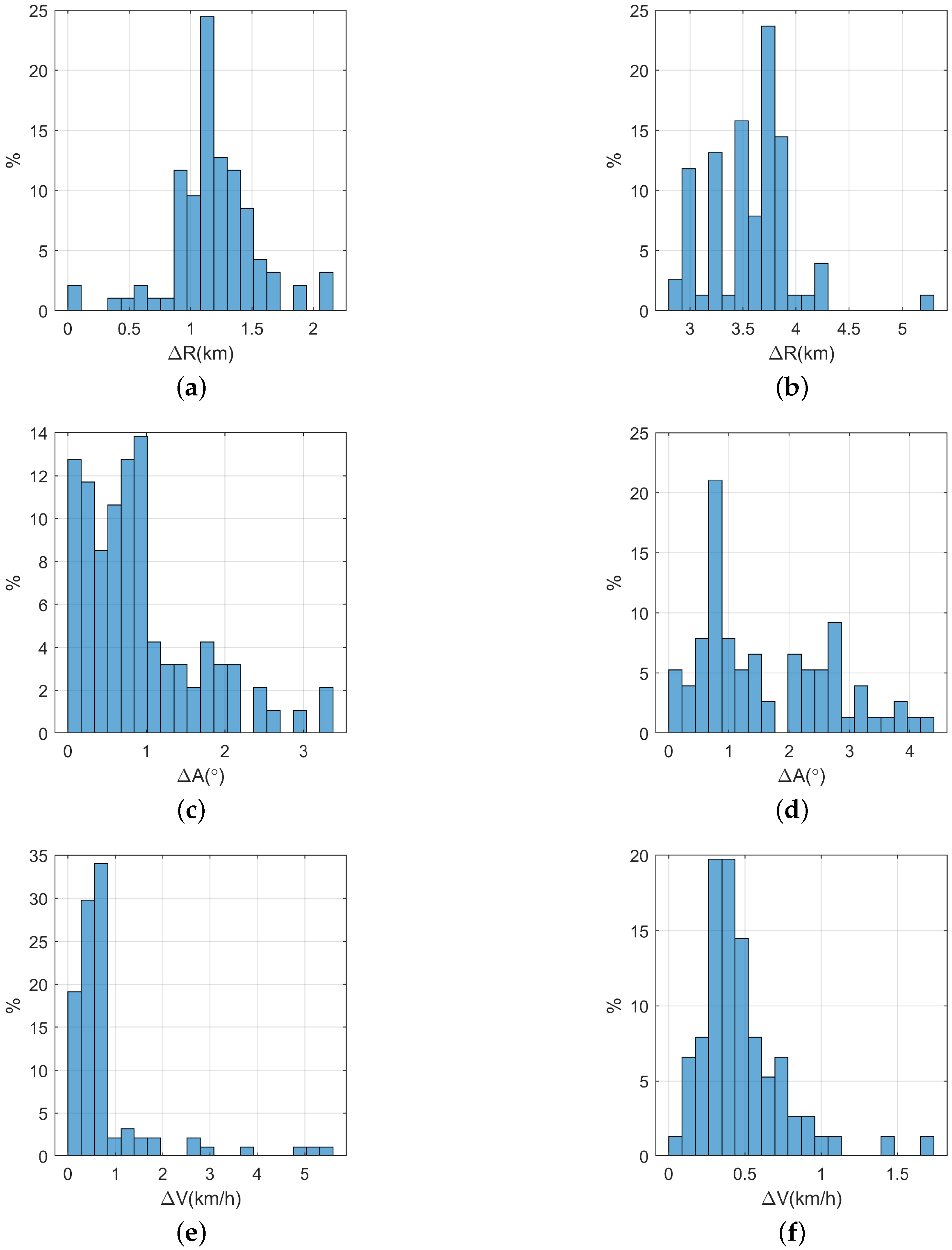
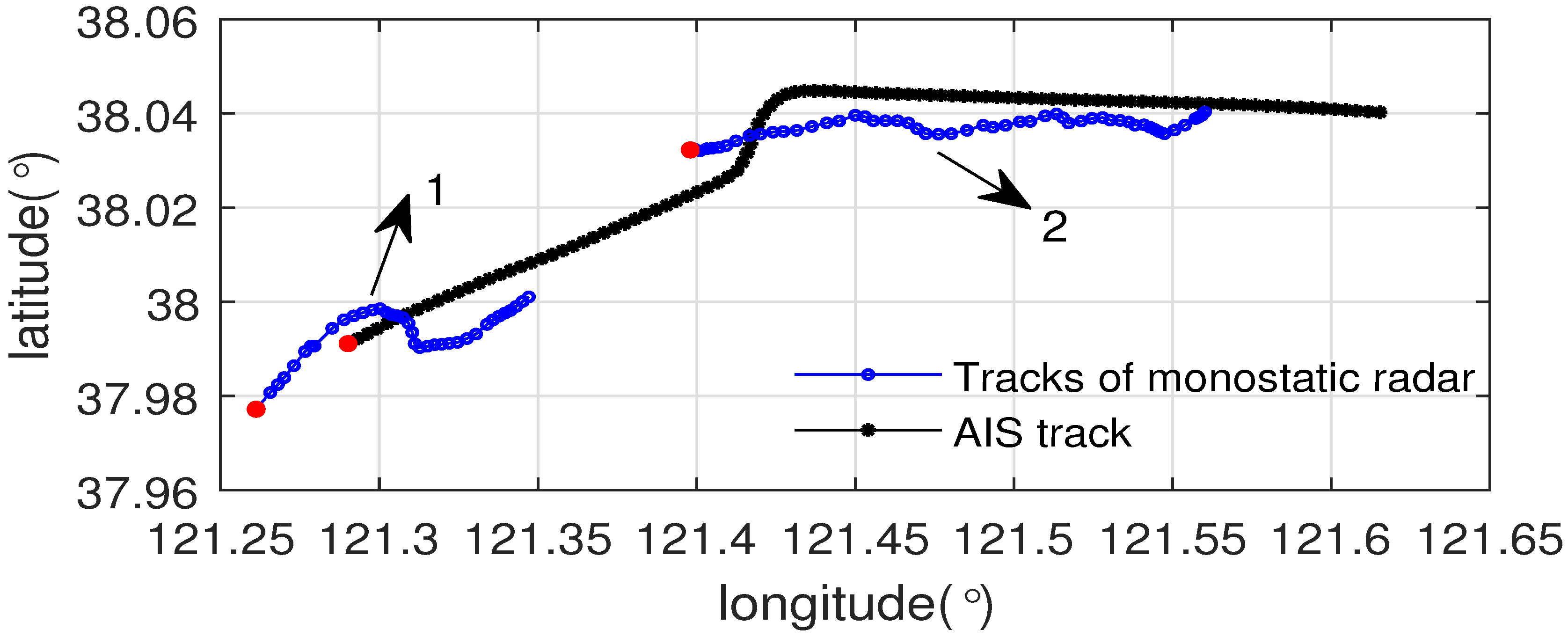
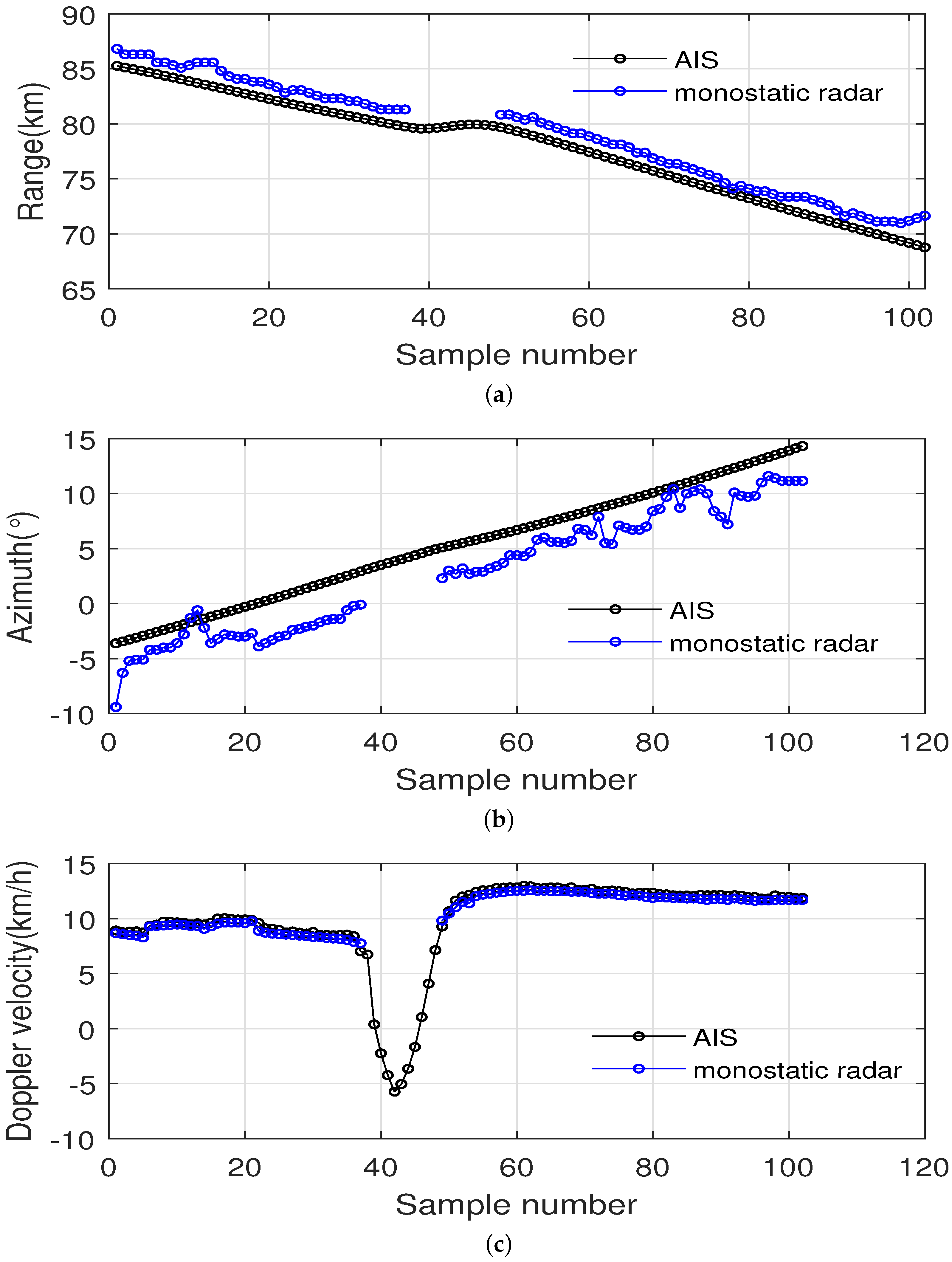

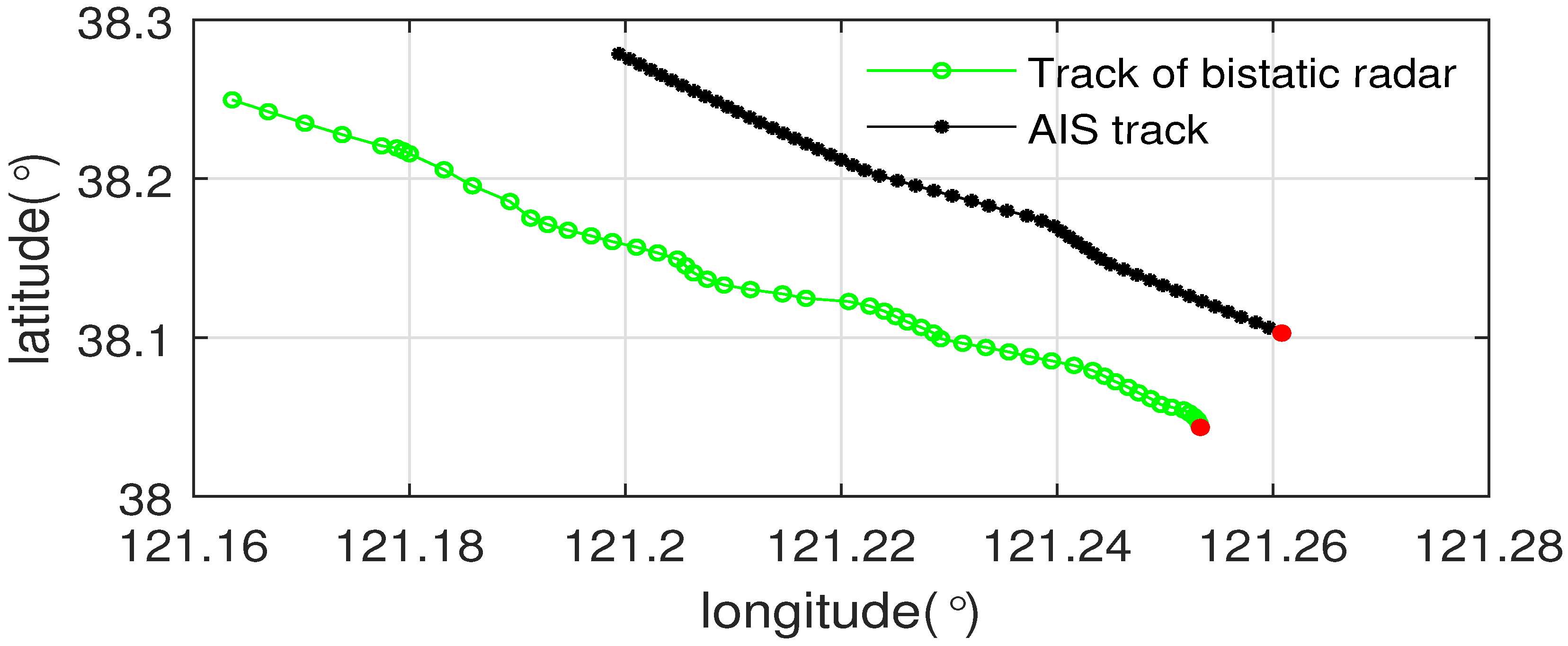
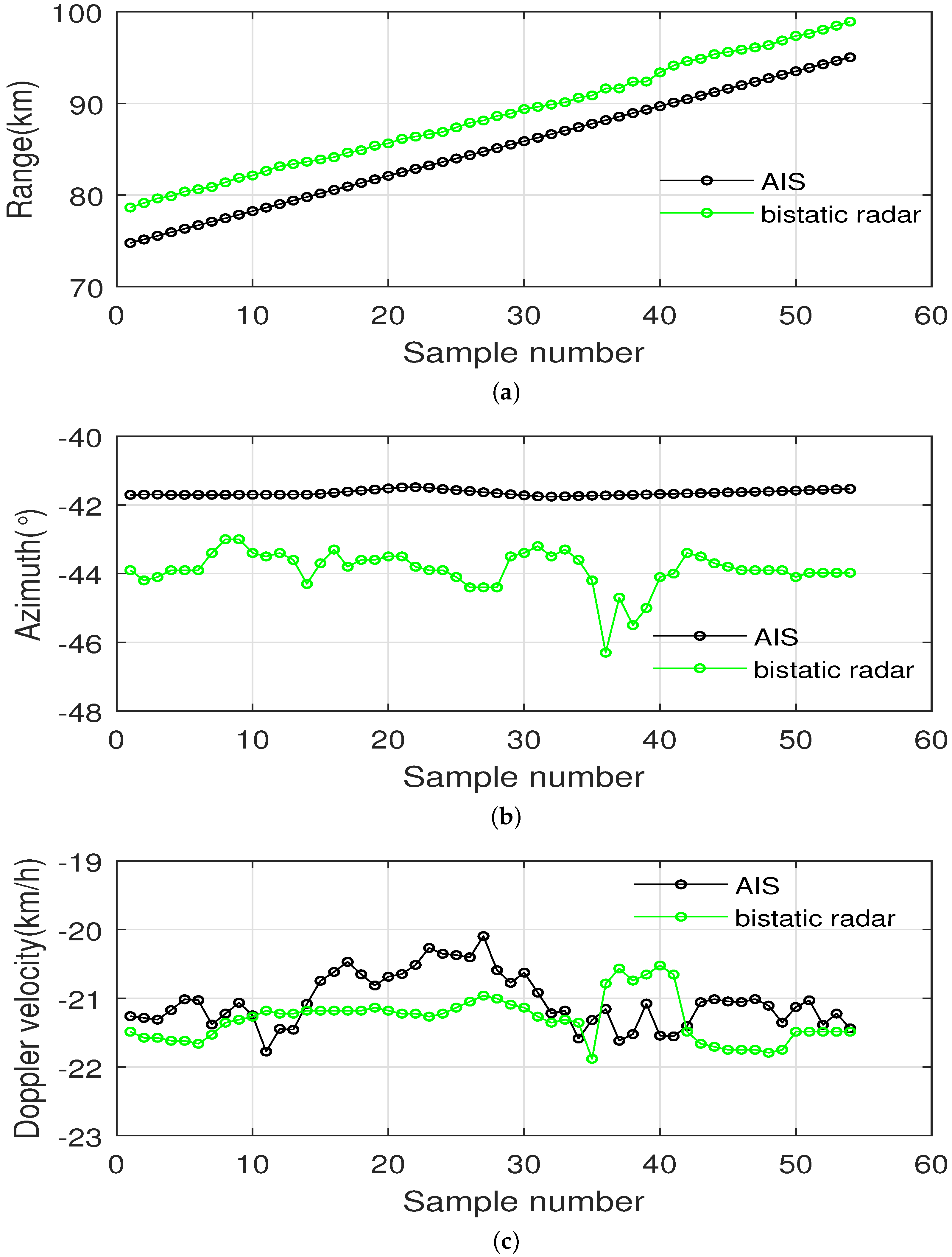
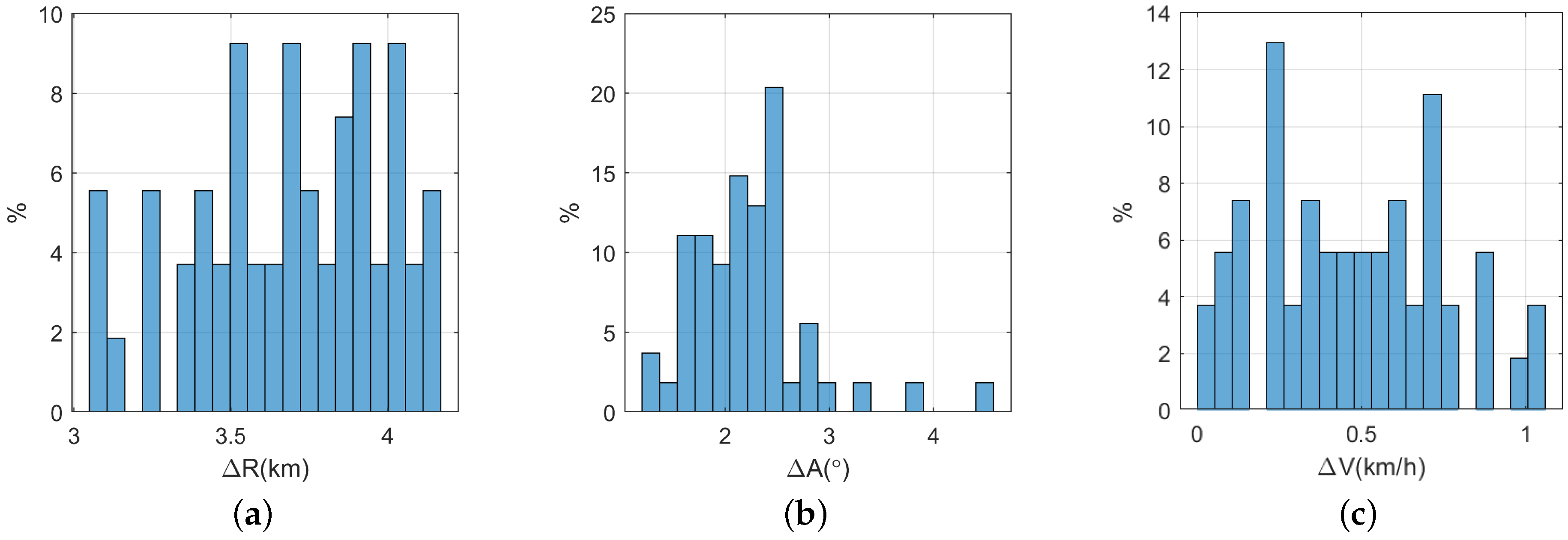
| Target 1 | Target 2 | Target 3 | |
|---|---|---|---|
| MMSI | 413331140 | 241491000 | 412328490 |
| Ship Name | HUI RONG | MARAN HELEN | ZHONGTIEBOHAI 1 HAO |
| Ship Type | Cargo | Tanker | Passenger |
| Length (m) | 98 | 274 | 182 |
| Width (m) | 16 | 46 | 25 |
| Draught (m) | 3.9 | 9.4 | 6.0 |
| Range (km) | Azimuth () | Doppler velocity (km/h) | |
|---|---|---|---|
| Monostatic radar | 1.24 | 1.18 | 1.30 |
| Bistatic radar | 3.60 | 1.94 | 0.55 |
© 2020 by the authors. Licensee MDPI, Basel, Switzerland. This article is an open access article distributed under the terms and conditions of the Creative Commons Attribution (CC BY) license (http://creativecommons.org/licenses/by/4.0/).
Share and Cite
Sun, W.; Ji, M.; Huang, W.; Ji, Y.; Dai, Y. Vessel Tracking Using Bistatic Compact HFSWR. Remote Sens. 2020, 12, 1266. https://doi.org/10.3390/rs12081266
Sun W, Ji M, Huang W, Ji Y, Dai Y. Vessel Tracking Using Bistatic Compact HFSWR. Remote Sensing. 2020; 12(8):1266. https://doi.org/10.3390/rs12081266
Chicago/Turabian StyleSun, Weifeng, Mengjie Ji, Weimin Huang, Yonggang Ji, and Yongshou Dai. 2020. "Vessel Tracking Using Bistatic Compact HFSWR" Remote Sensing 12, no. 8: 1266. https://doi.org/10.3390/rs12081266








